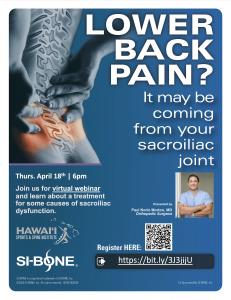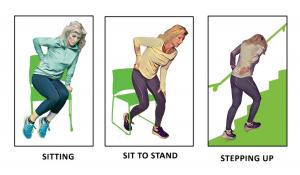
SUFFERING FROM LOWER BACK PAIN? JOIN HAWAII ORTHOPEDIC SURGEON PAUL NORIO MORTON MD FOR A WEBINAR ON APRIL 18TH

Dr. Paul Morton, an Orthopedic Surgeon in Hawaii, will present a webinar on April 18th, about commonly under-diagnosed SI Joint pain and an innovative solution to treat symptoms.
The Sacroiliac Joint may be a pain generator in at least 15-30% of patients with chronic lower back pain, yet it is often misdiagnosed.
WHO: Public invited to join the webinar.
WHAT. Sacroiliac (SI) Joint: A Cause of Low Back Pain
WHEN: Thursday, April 18, 2024, 6pm Hawaii Time9pm PST)
WHERE: Virtual Webinar
HOW: Please register here: https://bit.ly/3vr3e8F
WHY: If you or a loved one is suffering from lower back pain, we recommend you join us. SI Joint pain may be a pain generator in 15-30% or more of patients with chronic lower back pain. Dr. Morton will discuss this commonly under diagnosed cause of low back, hip, and pelvic pain and offer an innovative solution to treat symptoms of SI disorders.
Up to 85% of all people have lower back pain (LBP) at some point in their life. LBP is second only to the common cold as a reason for a physician visit. Despite all the attention to LBP, a major contributor is often overlooked as a pain generator. According to Dr. Morton, up to 30% of low back symptoms are related to the Sacroiliac (SI) Joint. And yet, most physicians were never trained to consider the SI Joint when evaluating a patient for back pain.
The Sacroiliac (SI) Joint forms the lowest segment of the spine and is located on either side of the sacrum in the low back and the pelvic areas. The SI Joint connects the sacrum, the triangular bone at the bottom of the spine, with the pelvic iliac crest. Strong ligaments encase each joint and allow for approximately two to four millimeters of movement during weight-bearing and forward flexion. When these ligaments become damaged—either due to normal wear and tear or by injury—they may have excessive motion. This excessive motion may inflame and disrupt the joint and surrounding nerves.
Underscoring the need for proper diagnosis is the fact that pain originating in the Sacroiliac Joint can mimic discogenic or radicular low back pain. “This could potentially lead to the wrong diagnosis and treatment that may not include the appropriate pain generator,” said Dr. Morton.
Some of the most common symptoms of SI joint dysfunction include:
Lower back pain (below L5)
Sensation in lower extremity; pain, numbness, tingling, weakness
Pelvis/buttock pain
Hip/groin pain
Feeling of leg instability (buckling, giving way)
Disturbed sleep patterns due to pain
Disturbed sitting patterns (unable to sit for long periods, sitting on one side)
Pain when going from sitting to standing
Your physician will want to perform several diagnostic tests to determine if your SI Joint is contributing in whole or in part to your symptoms. These tests may include provocative manipulation and injecting the SI joint with painkillers.
Treatment may involve physical therapy and SI joint injections to manage the pain. “For patients who are no longer responding to conservative care, the iFuse Implant System offers a minimally invasive surgical option,” stated D. Morton. “We strive to provide our patients access to the most innovative technologies and treatment options like the iFuse SI joint fusion system.”
The iFuse procedure is a minimally invasive surgery that stabilizes and fuses the SI joint. Typically, a surgeon places three small triangular titanium implants across the joint, and the triangular shape and strength of the implant resists movement and rotation of the joint. iFuse is the only device for treatment of SI joint dysfunction that is backed by significant published clinical evidence, including two randomized controlled trials.
To learn more about the iFuse Implant System please visit www.si-bone.com, or contact Dr. Morton at Hawaii Sports & Spine Institute for additional information. For indications, risks, and safety information about the iFuse Implant System, visit www.si-bone.com/risks.
ABOUT PAUL N. MORTON, M.D.
Dr. Paul N. Morton is an orthopedic surgeon at the Hawaii Sports & Spine Institute. He earned his Bachelors of Science degree, double-majoring in Chemistry and Biomedical Sciences, from Antioch College in Ohio, and returned to Hawaii to obtain his medical degree from the University of Hawaii John A. Burns School of Medicine (JABSOM). He pursued his Orthopedic surgery residency at St. Luke's University and Health Network in Bethlehem, Pennsylvania, and obtained his fellowship training in Adult Reconstruction at the University of Chicago. He pursued additional training through an AO Trauma fellowship at Charité – Universitätsmedizin Berlin in Germany. Dr. Morton has had several publications and his research has been presented in multiple national meetings including the American Academy of Orthopaedic Surgeons, American Association of Hip and Knee Surgeons, and the Orthopaedic Trauma Association.
Dr. Morton specializes in hips and knees. He is the first Orthopedic Surgeon in Hawaii who is Fellowship-trained in Robotic Joint Replacement. His love of robotic surgery has earned him the nickname, “The Robot Doc.” Dr. Morton believes robotic surgery is more precise, less invasive, has fewer complications, and will get his patients back out there feeling pain-free faster.
Dr. Morton's focus is on joint reconstruction, joint preservation and salvage procedures. He has an interest in minimally-invasive approaches, including the Direct Anterior approach, an alternative to conventional total hip replacement, and he is well-versed in modern adult reconstruction techniques including partial knee replacements and robotic-assisted replacements. He also has extensive training in complex revisions of failed joint replacements, including megaprosthesis, infections, arthrofibrosis and periprosthetic fractures.
Dr. Morton uses the latest technology, but still believes in providing old-fashioned, friendly, personalized care. He practices in Honolulu, West Oahu and Kona.
Mona K. Wood-Sword
IKAIKA Communications...a powerful little pr company
+1 808-218-5546
ikaikacomm@gmail.com
Visit us on social media:
Facebook
Twitter
LinkedIn
Instagram
YouTube
EIN Presswire does not exercise editorial control over third-party content provided, uploaded, published, or distributed by users of EIN Presswire. We are a distributor, not a publisher, of 3rd party content. Such content may contain the views, opinions, statements, offers, and other material of the respective users, suppliers, participants, or authors.



